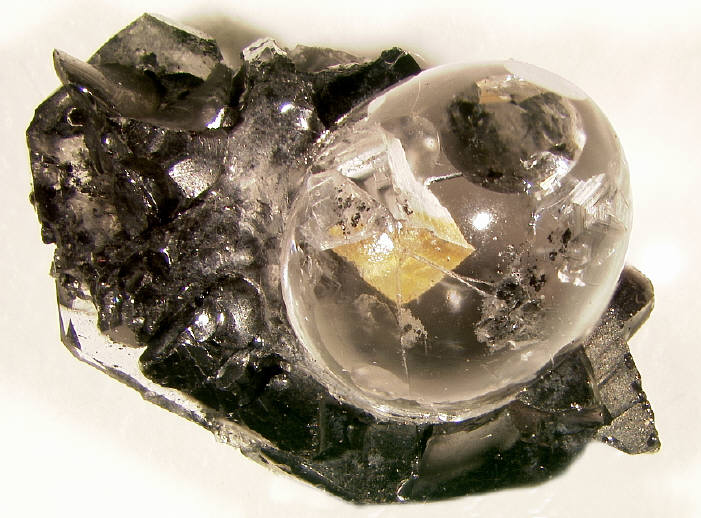The best website on "Herkimer Diamonds"
The formation of these spheres of quartz are important evidence for understanding the history of Herkimer diamonds. I do not know of these forms of quartz occurring naturally anywhere else in the world.
Quartz Spheres - Unique and Important

The specimen on the left is from the TCR location and part of the mine owner's collection (2009). It is about 1 cm across and shows most of the features that are common for these spheres. The spheres occur totally encased in hydrocarbon material and often contain one or more brilliant flat surfaces. This sphere also has a nice golden dolomite within it.
In the next two photos below you can see that these quartz spheres come in a variety of shapes, but never are they much larger than one cm in diameter. The photos each cover 2 cm across.



There is another very circular feature found associated with Herkimer diamonds - circular impressions on the outside of crystals. Below you can see the faces and edges of a Herkimer diamond. On those faces are round impressions. The phenomenon that caused these is likely related to the same phenomenon that helped form the quartz spheres. At the arrow you can see the relationship between the faces of the crystal and the effects of the circular phenomena (Specimen from N. Adams Bob, from Fonda, NY (DA) loaned for photography 2009).
It is difficult to naturally make round spheres of clear quartz. Were these water worn, like pebbles on a beach? There seems to be no evidence to support that, especially when we can see very well formed flat features on the spheres that are smooth as glass. Did these form by some natural accretion process during the time when the sediments were being made - like the way a pearl is made? There is no evidence of layering in these spheres like one finds in a pearl. The most likely explanation is that these were formed inside nearly perfect spherical cavities. These spherical cavities were inside the black carbon material, hydrocarbon, and the quartz filled in those spherical cavities leaving behind spheres.
How can you make nearly perfectly spherical cavities inside the hydrocarbon? The best explanation is that at one time the material was viscous, slightly fluid, like thick syrup. It was likely oil. This oil contained gas bubbles and as the oil became hardened the bubbles were trapped, the hydrocarbon hardened and the bubble left behind a spherical cavity. The quartz then found its way along the porus layers in the rock (layers filled with holes) and into the spherical cavity contained within the solidified oil. The quartz then filled in the bubble cavity making the sphere. We then find the quartz spheres totally encased in carbon material and not anywhere else.
These quartz spheres are some of the best physical evidence within the Herkimer district that oil was present and influenced the history of how Herkimer diamonds were made. It is difficult to generate a more plausible theory, particularly given that gas deposits are found in the Finger Lakes region with similar wall rock alteration features. It is likely that there were several episodes of oil migration and several episodes of quartz events. It is also likely that the intensity/timing and flow direction of these oil events, in relation to the Herkimer diamonds, varies across the district (as do all the fluid migration events) resulting in variations within the deposits across the Herkimer district.
Not all the spheres were made of quartz


